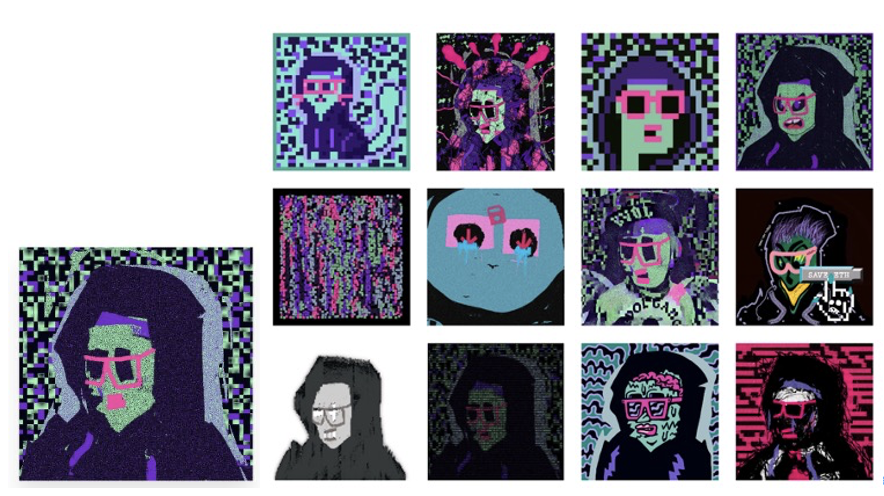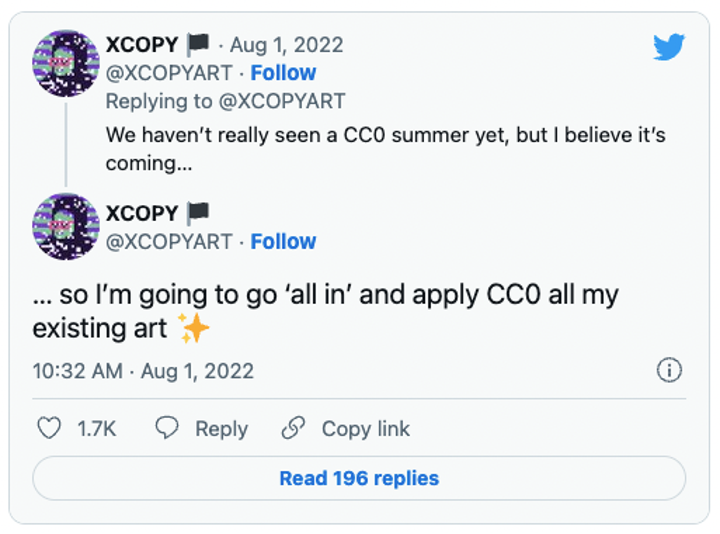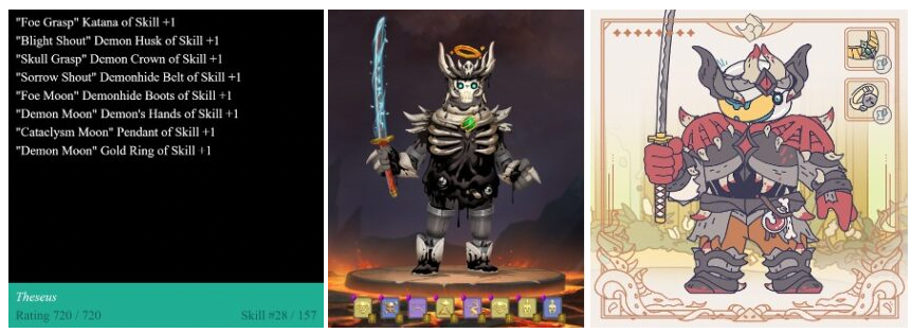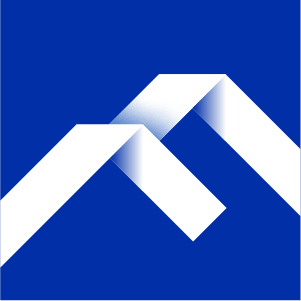Author: Flashrekt, Scott Duke Kominers
Compilation of the original text: Paimon
Thousands of innovative products are automatically entered into the public domain on January 1 every year, which also means that on "Public Domain Day", the copyright holder or creator renounces all rights to the artwork, including reproduction, adaptation or publication. ownership and are freely available to all. Movies, poetry, music, books, and even source code all apply this principle, and public domain protection for creations usually lasts for 70 years after the author's death.
The disclosure of copyright in the public domain opens the door to new worlds of uncreative works. In the first half of the year, about 400,000 recordings before 1923 and the first edition of "Winnie the Pooh" comics that have not yet become well-known employees of Disney have been put into the public domain and the copyright has been released. The author AAMilne could never have imagined that Pooh and her friends, born in 1926, would be given the color and expression of 2022 by the creatives in the community. Even in the works of some creators, the bear holding the honey pot has become the protagonist of the horror movie "Winnie the Pooh: Blood, Tears and Honey", with Pooh and Piglet as the villains co-starring.
Compared with the continuation of the original creative style of many classic IPs, experimental reconstruction may add more value to technological IPs, allowing the public to create second creations on the basis of existing technologies, which is also the core driving force of the open source movement. A large part of the reason why Android, Linux, and other successful open source software projects are so competitive is that they have the courage to embrace "permission-free innovation." The success of cryptographic systems, and especially the NFT community, in attracting public development is also due to its general acceptance of open source and "remix culture".
Grab the product memory point
Strategies for building brand, community, and content through IP vary widely across different NFT projects. Some projects more or less maintain the standard intellectual property protection system; others only give NFT owners the right to innovate on the relevant IP; and some projects choose to take off directly, completely removing the protection of copyright and other IP .
By releasing digital works with "Creative Commons Zero" or "cc0" permissions, creators can choose not to retain ownership separately while retaining the right to know. This authority allows everyone to safely and boldly make peripheral products without having to bear the legal consequences of "second creation". [Special note: There are no complete regulations on NFT copyright, so the so-called copyright here has nothing to do with law, finance, taxation or investment. This article focuses on cc0, the copyright loopholes of NFTs, and the behavior of creators to maintain the rights of owners]
The wide application of cc0 in the NFT field began with the Nouns project in the summer of 2021. Projects such as A Common Place, Anonymice, Blitmap, Chain Runners, Cryptoadz, CryptoTeddies, Goblintown, Gradis, Loot, mfers, Mirakai, Shields, and Terrarium Club have followed up quickly, and more and more high-quality new Derivatives.
image description

"Right-click Save As Guy" by XCOPY (left) / XCOPY original derivative (right)
On Monday, X_COPY went straight to the big ticket, announcing its intention to "all-in" and apply cc0 to all artworks. The artist added: "We haven't really seen a cc0 summer yet, but I believe it's coming..." -- perhaps hinting at a potential growth period for cc0, similar to 2020 that attracts The "Summer of DeFi" of countless decentralized followers.

Why are so many NFT creators taking the path of "no copyright"?
One reason can be simply boiled down to "all for culture", which is to promote the development of native projects to bring about a more vibrant and engaged community. This is particularly meaningful in the background of encryption. Open sharing, finding and building communities are part of the core philosophy of many encryption enthusiasts.
Creative works live and die by their cultural relevance. Although NFT has the natural ability to prove the ownership of all digital items, so that the author does not need to consider licensing issues, and cc0 is to extend the "memory curve" of the original work by giving everyone unimpeded re-creation rights-when new derivatives Constantly appearing and disseminating, people's attention will naturally flow to the original work, enhancing its attention in the entire encrypted world, thereby stimulating more re-creations and generating a flywheel effect-every derivative can increase the value of the original work, Similar to the platform network effect, that is, the joining of users makes the platform more valuable to users.
In other words, cc0 makes it easier for creatives to "capture the memory of the product."
However, the application of cc0 in the entire digital field has just begun-real-world physical products are also producing derivatives of cc0NFT assets. The iconic square-frame glasses (“one per day, forever”) on the NounsDAO NFT have been made into luxury sunglasses that can be worn by the Nouns Vision project. Blitmap's pixel art has appeared completely freely on shoes, clothing and hats from various production companies. This is obviously in sharp contrast to the traditional intellectual property model, where a single owner has a strong say in creation, licensing and production.
Hats with the Blitmap logo actually have multiple cc0 levels: the bottom layer cc0 entity "blitcap" is actually a derivative with the characteristics of the second layer cc0 Chain Runner series, which is also the first layer cc0 Blitcap logo "original" The product. This logo is in fact Biltmap's token 84 creation, and one of several "originals" in the series that are often inspired to create (others are "Dom Rose", token #1, etc.). The "tribute to the classics" of the two creators also reflects the huge influence of Blitmap in the entire encrypted world as the leader of cc0 and as one of the first major NFT projects that announced to enter the public domain.
image description
Physical Blitmap Logo Hat (1), Chain Runners #780 ft. Blitmap Hat trait (2) and the Blitmap Original 「Logo #87」 (3)
Open source embraces co-creation
Since it is built on smart contract technology, part of the power of NFT comes from the inherent composability of technology. Many smart contracts are developed as "building blocks", that is, through combination and stacking, richer applications can be realized.
As the "money Lego" is used to describe the composition of decentralized finance ("DeFi") smart contracts, they are interconnected to form new financial use cases. (For example, yield aggregator Yearn interacts with MakerDAO’s stablecoin $DAI and exchange liquidity provider Curve, etc., simply by calling public functions on their smart contracts) From the same composability perspective , NFT and its underlying smart contracts can be used as the basic conditions for culture and creativity to have the ability to reorganize and splicing.
image description
Game concept from HyperLoot, a spinoff of Project Loot showing multiple cc0 projects as controllable characters in a fictional game
For the more far-reaching "open source", cc0 can even stand on the same level as the rise of Linux. In the year when web2.0 was still a new concept, Microsoft controlled most of the operating system market with its closed-source operating system Windows. But Linux (and its creator Linus Torvalds) advocates the spirit of community first, open source code for everyone to use and modify, without any restrictions on dissemination. The open source of Linux directly allows "developers all over the world to unite" to create everything including web servers, databases, and connection systems for Linux. The value proposition of Linux was enhanced by the worldwide availability of open source software in the system, ultimately leading to explosive growth and further innovation across the industry. Today, Linux accounts for more than 96.3 percent of the top 1 million web servers and 85 percent of smartphones, according to market analyst firm Truelist.
As cc0 licensing begins to empower NFT community builders in a similar way, one can imagine a long-term trajectory for innovation. According to the "logic-lego" concept of punk4156, the co-founder of NounsDAO, the combination of cc0 and NFT will "transform confrontational games into cooperative games." This vision has several important points: first, since decentralized systems from open source to encryption are about trust and coordination between strangers, facilitating opportunities for cooperation is the key to success; second, in the world of NFTs, such Cooperation strengthens people's ownership of digital assets, giving them the motivation to continue to create while holding assets, and thereby enhance the artistic value of original digital assets, forming a virtuous circle.
A "license" of creativity
If the cc0 project resembles a single open source "application" or "platform", the NFT artwork, metadata, and smart contracts provide the "user interface", while the underlying blockchain (such as Ethereum) is the "operating system". However, in order for these applications to reach their Linux-like potential, more supporting infrastructure services need to be created and invoked at any time so that one can maximize the "reverberation" opportunities created by cc0.
These services are already starting to take shape. For example, the "hyperstructure" Zora protocol and OpenSea's open-source Seaport protocol are the technical foundations for building an open and permissionless marketplace for NFT transactions. Recently, a pixel art rendering engine was publicly released on the Ethereum blockchain and has been integrated into projects such as OKPC and ICE64. Every successful application will add fire to the blockchain's ability to meet the "ready-to-eat" standard, and more and more new applications will be born in increasingly stronger blocks.
While web3 developer growth is at an all-time high and expanding rapidly, the total is still only a small fraction of the world's active software developers. Fortunately, as more and more developers enter this field, ambitious NFT projects may look for more creative "Lego" to provide the technical cornerstone for the cc0 project and other projects.
Composability is key to growth. Since these digital assets are built on public standards with an interoperable infrastructure as the cornerstone, putting assets on various platforms is a breeze for users. An example of this scalability in practice is the Loot project, one of the first pioneering projects to demonstrate decentralized co-creation, world-building, and more in NFTs. We share this example because it is obviously "flawed" or even "incomplete" from an aesthetic point of view, but it also leaves more room for the imagination and community co-creation of all crypto enthusiasts.
A little background on Loot here: Loot started as a series of Loot NFTs, each consisting of just a simple list of eight "adventure items" in white on a black background (such as "Katana, Divine Robe" for loot bag #5726 , Great Helm, Wool Sash, Divine Slippers, Chain Gloves, Amulet, Golden Ring"). Released for free by original creator Dom Hofmann, these loot bags are a starting point for community building.
Several projects have indeed begun to develop everything from world view building to world modeling (game development) in a short period of time, and creators from all sides have contributed many derivatives to "Lootverse". They've made games (Realms & The Crypt); characters (Genesis Project, Hyperloot, and Loot Explorers); storytelling projects (Banners and OpenQuill); and even level infrastructure (The Rift).
So how do cc0 and composability apply here? Users control the foundational Loot Bags—an "initial bag" that makes sense in many different games and worldviews—and users can use these core assets anywhere after connecting their wallets. This feature also allows them to participate in numerous spin-off projects including Genesis Adventure, whose special characters are featured in other projects, basically realizing a decentralized franchise that does not belong to any one entity.

When is the summer of Cc0 coming?
As mentioned above, there are many strategies NFT projects can adopt when developing and building their IP. When it comes to cc0, it's the word "reality" that matters. A license is not an Aladdin's magic lamp that can easily turn any project into a blockbuster - expecting the public domain to suddenly make something as successful as it will ever be is simply impossible. Just like open source software, cc0 works best for potential stock NFTs that can empower the ecosystem.
Many of the most successful cc0 projects to date have succeeded by introducing intellectual property that can be used flexibly in a range of different contexts. Brand Nouns are as intuitive for beer commercials as physical glasses; Loot Bags are a starter prop for big adventures; and Goblintown's art style looks as good on dwarves, zombies, and cranky owls as it does on Val Kilmer.
There is reason to believe that the ideal cc0 NFT project creates opportunities for builders to add value, both vertically, by stacking new content and features directly on top of the original cc0 assets (e.g. games built on the Loot ecosystem, etc.) , and horizontally, to help spread the brand of the original cc0 project (such as various Goblintown spinoffs, etc.) by introducing different but related intellectual property.
Because cc0 NFT projects typically receive ongoing royalties from secondary sales, third-party extensions and derivatives can be a source of revenue by driving increased demand for the original cc0 asset, allowing business models around cc0 NFT projects to benefit directly from these activities benefit from.
In addition, cc0 can reduce commercial disputes. The obsession with copyright may lead some "rebellious" brands to ignore authorization and forcefully launch derivatives, or even "bypass" the original. As Robbie Broome, head of cc0's project A Common Place, explains: "By handing over my intellectual property to cc0 rather than 'protecting' it, it avoids the next bad repeat. For example, if UrbanOutfitters wants to put my design in On t-shirts, instead of hiring someone on their team to design something that looks like it, they can just use the actual work.” Sometimes, adopting cc0 can effectively turn a competition into a collaboration.
Additionally, cc0 projects can greatly benefit from community recognition of the value and contribution of core assets. Community cohesion and engagement are paramount here. Based on the examples already mentioned above. While developers can in principle create adventure games around any theme and item concept they want, many choose to build around Loot bags reflecting the community cohesion within the Lootverse. Meanwhile, Flipmap, a Blitmap spin-off project, shared some of their income with original Blitmap artists in recognition of the project's centrality in the community, a move that promotes a healthy culture within the cc0 project ecosystem. As noted by cc0 project commentator NiftyPins, "It's a smart move that pays homage to the people who built the foundations of their universe. It also provides an environment for many OG Blitmap artists to speak freely".
However, cc0 is not a solution that the entire crypto world is falling for - for example, NFTs built around established brands may prefer to opt for a more restrictive license to protect their existing intellectual property and Strengthen exclusivity. Furthermore, while cc0 has similarities to those strategies where owners specifically commercialize NFT-related IP (like à la Bored Ape Yacht Club), the key difference is that cc0 holders have no right to prevent others from using the same IP . It is thus more difficult for holders to brand commercially on cc0 assets, or to grant specific rights to partners, although the rights introduced are still in the hands of the holders, who can still choose IP (such as backstory or derivative Taste).
Decentralization and open development are core elements of blockchain technology and the broader ethos of cryptocurrencies. This makes it very natural for cryptocurrency projects to build around the cc0 content model — a model built on a foundation of creative consensus and several groundbreaking open source pioneers — and may represent one of the purest manifestations of the "open source philosophy" to date. one.
Like initiators of open source software projects, NFT creators who choose cc0 must decide what role they will play in forming the ecosystem around them. Some cc0 project leaders, such as the creators of Chain Runners, continue to build on the original cc0 assets, actively establishing an environment on which spin-off projects can base themselves. In contrast, Dom Hofmann stepped back from Loot, leaving the community in charge. (Dom is said to be developing other cc0 NFT projects as part of supporting development of companies like Blitmap). Other creators have opted out entirely, such as someone who recently went by the pseudonym sartoshi announced his withdrawal from mfers, the cc0 project he developed, and the NFT space entirely, releasing a final version, aptly titled "The End of sartoshi", Then deleted his Twitter account. The smart contracts of the mfers project are now controlled by the multi-signature wallets of seven mfer community members.
Original link



